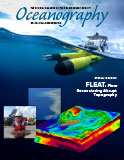Article Abstract
Due to the presence of a well-defined permanent thermocline, low-frequency upper ocean circulation variability in the tropical western Pacific Ocean is effectively captured by the region’s linear baroclinic Rossby wave dynamics. A careful examination of variations in the circulation surrounding Palau using in situ temperature measurements, satellite altimetry data, and ECCO2 (Estimating the Circulation and Climate of the Ocean, Phase II) ocean state estimates reveals that linear dynamics fails to describe the observed large-amplitude upper ocean variations on monthly timescales. These short-timescale variations are particularly active during the transition from El Niño to La Niña conditions. As an El Niño event terminates and the tropical trade winds rebound, downwelling baroclinic Rossby waves are generated across the off-equatorial Pacific basin. When these wind-forced Rossby waves propagate into the western North Pacific basin, they deform the pre-existing, horizontally sheared, North Equatorial Countercurrent (NECC) and subject it to barotropic instability. By breaking down into large-amplitude eddies, the unstable NECC generates rapidly evolving upper ocean changes with sea level, temperature, and meridional velocity fluctuations exceeding 0.5 m, 10°C, and 0.5 m s–1, respectively, over a period of one to two months around Palau. This variability in short-term, large-amplitude upper ocean circulation results in significant regional water mass and ecosystem changes.

